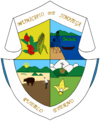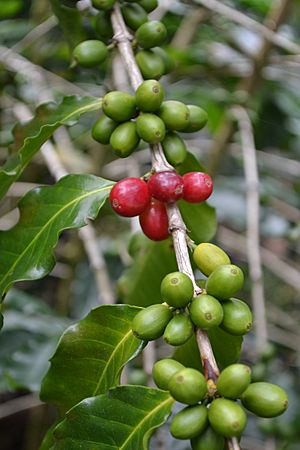Jinotega facts for kids
Quick facts for kids
Jinotega
|
|||
|---|---|---|---|
|
City
|
|||
|
|||
| Country | |||
| Department | Jinotega | ||
| Municipality | Jinotega | ||
| Founded | 1891 | ||
| Elevation | 1,000 m (3,000 ft) | ||
| Population
(2022 estimate)
|
|||
| • City | 56,910 | ||
| • Demonym | Jinotegano/a | ||
| • Municipality | 150,146 | ||
| Time zone | UTC−06:00 | ||
| Area code(s) | Ni-Ji | ||
| Climate | Aw | ||
| Website | http://www.alcaldiajinotega.gob.ni/ (in Spanish) | ||
Jinotega is a city in north-central Nicaragua. It is the capital of the Jinotega Department. The city's name comes from the Náhuatl language. It means 'place next to the jiñocuajo trees'.
Jinotega is in a long valley. It is surrounded by cool mountains. The city is about 142 kilometers (88 miles) north of Managua, Nicaragua's capital. In 2012, the Jinotega Department had over 417,000 people. About 123,000 lived in the city itself.
Jinotega is famous for its coffee. It produces 80% of Nicaragua's coffee. This coffee is sent to countries like the United States, Russia, Canada, and Europe.
The city has several rivers and a large artificial lake called Lake Apanas. This lake helps make electricity for much of Nicaragua. Jinotega is often called "The City of Mists" because clouds often float through the valley. It is also known as "The Eternal City of Men."
Jinotega shares borders with many other towns:
- To the north: Santa María de Pantasma and Wiwili
- To the south: Matagalpa and Sébaco
- To the east: El Cua, Bocay, and Tuma La Dalia
- To the west: La Trinidad, San Rafael del Norte, La Concordia, and San Sebastian de Yali
Contents
Geography of Jinotega
Jinotega is surrounded by beautiful natural features.
- Mountains: Cuspire, Chimborazo, Kilambe (1750m), Peñas Blancas, Zinica, Saslaya, Baba, Asan Rahra.
- Valleys: Jinotega city, Pantasma, Cuá, Wiwilí, Wamblan, Bocay.
- Rivers: Coco, Yali, Montecristo, Pantasma, Cua, Wamblan, Ulwaskin, Bocay, Wina, Amaka, Tuma, Viejo.
- Lakes: Apanas.
The climate in Jinotega is subtropical in the high valleys. It is dry in summer and rainy in winter. The mountains are cool.
What's in a Name? The Etymology of Jinotega
The name Jinotega has an interesting history. Many believe it comes from the Nahuatl word xinotencátl. Experts have different ideas about what this word means.
Some think it means "City of the Eternal Men." Others translate it as "neighbors of the Jiñocuajo trees." The word xiotl likely comes from xiokwawtli, which means jiñocuajo or mangy tree. The ending -tenko means "on the edge of" or "next to." The ending -katl is used for people from a place. So, xiotenko means "place next to the jiñocuabos."
The "jiñocuajo" (or bursera simaruba) is a special tree. It is very common in the Jinotega region. Ancient people in Jinotega thought this tree had healing powers. They also saw it as a symbol of eternity and wisdom. This makes the "neighbors of the Jiñocuajo trees" meaning very likely.
Some historians, like Eddy Kühl Aráuz, think the name Jinotega does not come from Nahuatl. They believe the local people spoke a different language called Misumalpa. However, some Nahua people did live in Jinotega. So, a Nahuatl origin is still possible.
A Look Back: The History of Jinotega
Jinotega has a long and rich history.
Early Times: Pre-Colonial Era
The first settlement in Jinotega was built by indigenous people. This was long before Europeans arrived. Historians disagree about who these first settlers were. Some think they were descendants of the Mayangna people from the Caribbean coast. Others believe they were Chorotega-speaking people from Central America.
The early people of Jinotega had a king. He was advised by a group of elders. They believed in many gods, like gods of air, thunder, rain, and harvests.
Their main food was corn. They also grew beans and cocoa. They hunted animals like turkey, quail, and deer. The people of Jinotega were skilled at making clothes from cotton and tree bark. They also made beautiful pottery and worked with gold.
Spanish Arrival: Colonial Era
When the Spanish arrived in 1524, Jinotega was still an indigenous town. A Spanish count in 1581 showed no Spanish people living there. However, the Spanish claimed the land. In 1606, a Catholic priest named Juan de Albuquerque named it "San Juan de Jinotega." He chose Saint John the Baptist as the city's patron saint.
Over time, more Spanish settlers came. By 1731, some Spanish families were living in Jinotega. In 1851, Jinotega was officially recognized as a village by the Nicaraguan government. Later, in 1883, it became a town.
Modern Times: Recent History
Jinotega has seen many conflicts. Its remote location and closeness to the Honduran border made it a hiding place for rebel groups.
From 1927 to 1934, Augusto C. Sandino and his troops fought against American soldiers in the Jinotega Department.
Later, in the late 1970s, Jinotega was a key battleground. The Sandinista National Liberation Front fought against the government of Anastasio Somoza Debayle. The Sandinistas won in July 1979.
After a short peace, another civil war started. This was between the new Sandinista government and the Contra rebels. The Contras were supported by the United States. This conflict, part of the Nicaraguan Revolution, lasted into the 1980s.
Economy of Jinotega
Jinotega is very important for Nicaragua's economy. It is a major producer of coffee. The region also grows basic foods like corn, beans, and wheat. Many vegetables are grown here, including tomatoes, lettuce, onions, and potatoes. Fruits like bananas and cocoa are also produced. Livestock farming, with cattle, pigs, and goats, is another important part of the economy.
Coffee Production
Coffee farming greatly boosted Jinotega's economy in the late 1800s and early 1900s. It attracted many business people from Nicaragua and other countries like Germany and Britain. Jinotega's climate and dedicated farmers help produce some of the best coffee in the world.
Jinotega coffee has won many national and international awards. It has won the "Cup of Excellence" contest five times. Most coffee farms are small or medium-sized. Jinotega produces 65% of all Nicaraguan coffee. This makes it the "capital of coffee." The coffee is exported to Canada, the United States, Europe, and Russia.
Commerce and Trade
In the past, Jinotega was a busy trading center. Foreign investors came to grow coffee. A German businessman, Heinrich Gülke, even opened a fancy casino. He also brought the first car to Jinotega in the late 1920s.
Later, in the 1960s, a factory processed coffee and corn. It made ground coffee, corn chips, and tortillas. These products were sold across Central America.
Today, coffee and other basic foods are often sold through middlemen. They collect, store, and then sell the products. Vegetables are usually sold directly from farms to local markets. Cattle are sold to slaughterhouses in other cities in Nicaragua.
Infrastructure and Services
Jinotega gets its electricity from the national power grid. A hydroelectric plant called Centro América Plant helps power much of the country. This plant has two turbines, each able to produce 25 megawatts of power.
Public lighting is available in most of the city (90%). However, only about 30% of rural areas have streetlights. Some rural communities still do not have electricity.
Learning and Education
Jinotega has several options for education.
Universities
- Public Universities:
- Universidad Nacional Autónoma de Nicaragua León (UNAN)
- Universidad Popular de Nicaragua (UPONIC)
- Private University:
- Universidad del Norte de Nicaragua (UNN)
Technical Schools
- Instituto Nacional Tecnológico (INATEC)
Famous People from Jinotega
- Benjamín Zeledón: A hero who fought against U.S. Marines in 1912. He was born in La Concordia, Jinotega.
- Bartolomé Martínez Hernández: A former President of Nicaragua.
- Otto de la Rocha: A talented guitarist, singer, and composer.
International Connections
Jinotega has "sister city" relationships with other cities around the world. These connections help promote cultural exchange and friendship.
|
|
More About Jinotega: Books to Read
If you want to learn more about Jinotega, here are some books:
- Nicaragua en mis recuerdos by Dr. Simeón Rizo Gadea (in Spanish)
- Monografía de Jinotega by Julián N. Guerrero and Lolita Soriano (in Spanish)
- The Naturalist in Nicaragua by Thomas Belt (in English)
- Los alemanes en Nicaragua by Dr. Götz von Houwald (in Spanish, about Germans in Nicaragua)
- Raices del centro-norte de Nicaragua by Eddy Kuhl (in Spanish, about the history of central-north Nicaragua)
See also
 In Spanish: Jinotega para niños
In Spanish: Jinotega para niños







